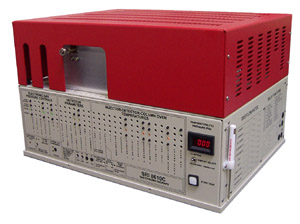
CHM3120L
Introduction to Analytical Chemistry: Laboratory
| Lab Schedule |
| LON-CAPA Pre-Labs |
| Resources |
| Contact Instructor |
| Chemistry Home Page |
![]()
Quantitative Analysis of Hydrocarbons by Gas Chromatography: Report Template
- Read the ASC files of one of your isothermal chromatograms and one of your temperature-programmed chromatograms of the four-component mixture into Excel. Prepare a graph plotting the two chromatograms on the same time axis, counts versus time in minutes. You will need to generate data for the x-axis. The data points are acquired at intervals of 1 second.
- For each peak in your isothermal chromatogram calculate the retention factor, k, and the number of theoretical plates, N,. Calculate N from: N = (5.55 x tr2)/(W1/2)2. You can find W1/2 by looking at the data in your spreadsheet to find the points at which the signal drops to half the maximum value for each peak. If your peaks are sitting on a pedestal (that is, the baseline value is not zero), you need to remove the pedestal before finding the peak maximum and the half-maximum points. Tabulate your isothermal results in a table organized as shown below. Put in a caption for the table that includes the temperature, flow rate, and the identity of the chromatograph (GC1, GC2, …) you used.
- Calculate and report the resolution for the pentane/hexane pair of peaks for the isothermal chromatogram. Resolution is defined as the ratio of the peak separation divided by the average base width of the two peaks. To get the base width find the width of the peak at the half-maximum point and multiply by 2.
- Prepare a graph (using Excel) of log tr’ versus carbon number (as abscsissa). Have the equation of the linear regression line and the R2 value appear on the graph.
- Prepare a separate graph showing the chromatogram of your unknown.
- Tabulate your quantitative analysis results in a table organized as shown below.
- Cut and paste your table of isothermal data and the first two graphs on one page and the chromatogram of your unknown sample and table of quantitative results on a second page. Be sure these include your name and the identifying code for your unknown.
Table of isothermal data
Component |
Carbon No. |
b.p., deg C |
tr, min |
tr', min |
log tr' |
W1/2, min |
ret factor |
N |
air |
|
|
|
|
|
|
|
|
pentane |
5 |
36 |
|
|
|
|
|
|
hexane |
6 |
68 |
|
|
|
|
|
|
heptane |
7 |
98 |
|
|
|
|
|
|
octane |
8 |
125 |
|
|
|
|
|
|
Table of quantitative data from programmed temperature chromatograms
Component |
Density, g/mL |
Known sample |
Unknown sample |
||||
area |
mg |
area/mg |
area |
mg |
wt% |
||
pentane |
0.6262 |
|
|
|
|
|
|
hexane |
0.6594 |
|
|
|
|
|
|
heptane |
0.6838 |
|
|
|
|
|
|
octane |
0.7025 |
|
|
|
|
|
|